Introduction
Materials and Methods
Sample preparation
Tissue preparation
Real-time polymerase chain reaction
Table 1
Immunohistochemistry
H&E and Nissl staining
Stereological study
Number of neurons and glial cells
Tunel assay
Reactive oxygen species
Glutathione disulphide content assessments and GSSG assay
SDS-PAGE sample prep and gel electrophoresis
Immunoblotting
Statistical analysis
Results
Evaluation of the sample
Real-time polymerase chain reaction
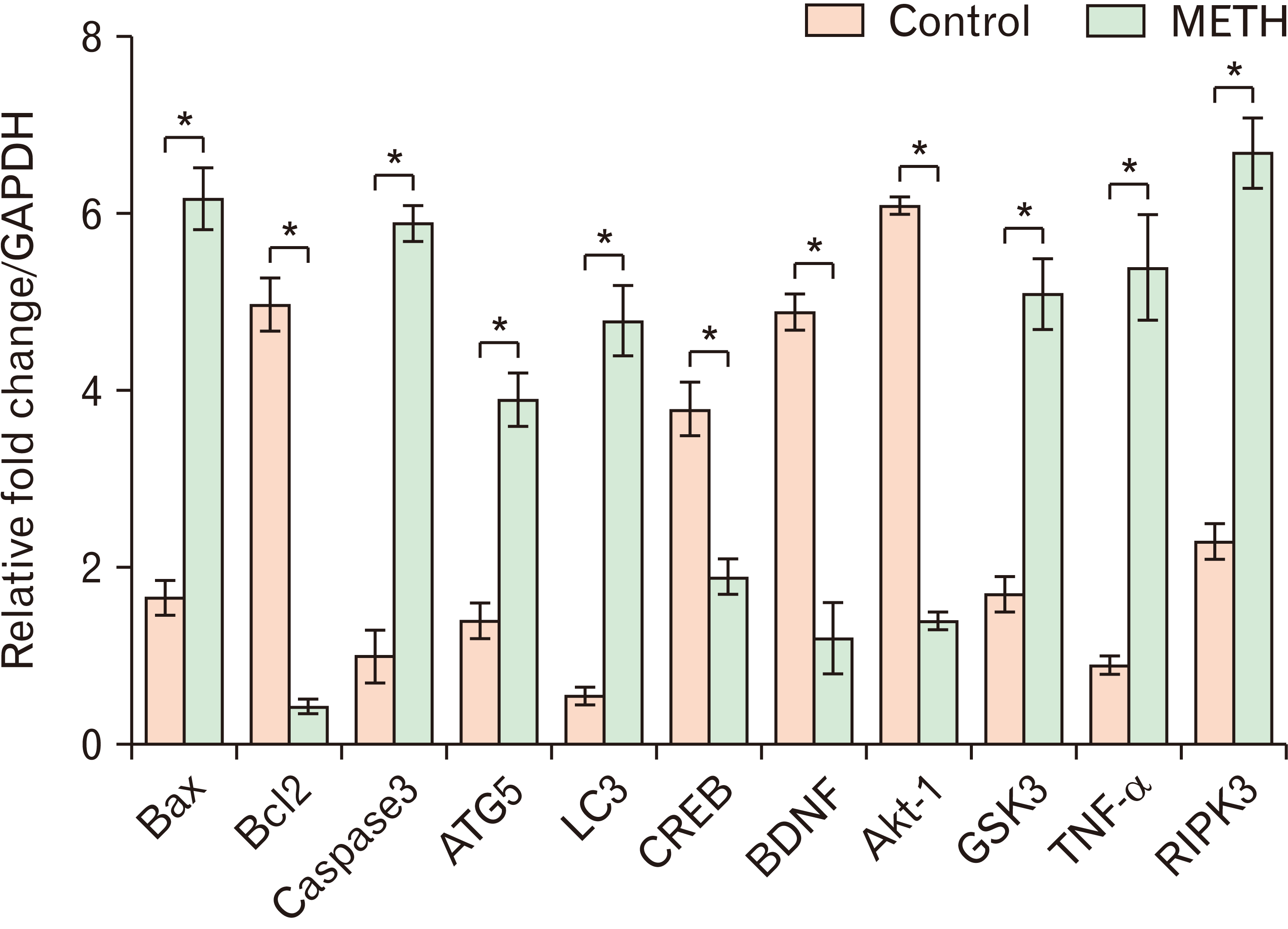 | Fig. 1Relative quantitative expression levels of key genes in METH and control groups. This figure illustrates the relative quantitative expression levels of critical genes, including CREB, BDNF, Akt-1, GSK3, TNF-α, RIPK3, Caspase 3, Bax, Bcl2, LC3, and ATG5. The outcomes highlight the substantial impact of METH on gene expression, resulting in noteworthy variations involving both upregulation and downregulation of target genes (*P<0.05). METH, methamphetamine; CREB, cAMP response element-binding protein; BDNF, brain-derived neurotrophic factor; TNF-α, tumor necrosis factor-α. |
Immunohistochemistry result
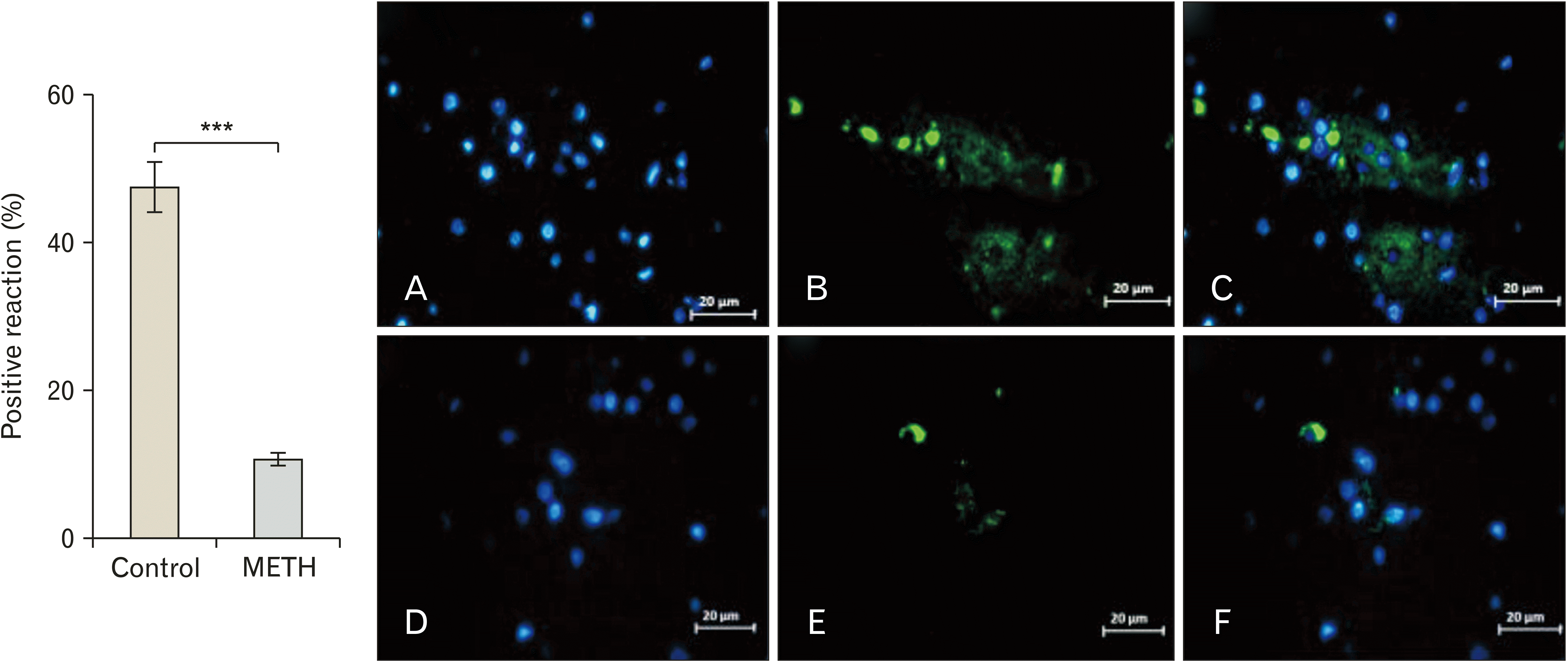 | Fig. 2Expression of CREB in control and METH groups. This figure portrays the distinctive expression patterns of CREB in the control (upper row) and the METH group (lower row). The images showcase the cellular nuclei staining using DAPI (Abcam) (A, D), the CREB immunostaining (B, E), and the merged images (C, F). The results effectively demonstrate the significant reduction in CREB expression due to METH exposure within the METH group, with these changes holding substantial significance (***P<0.001). CREB, cAMP response element-binding protein; METH, methamphetamine. |
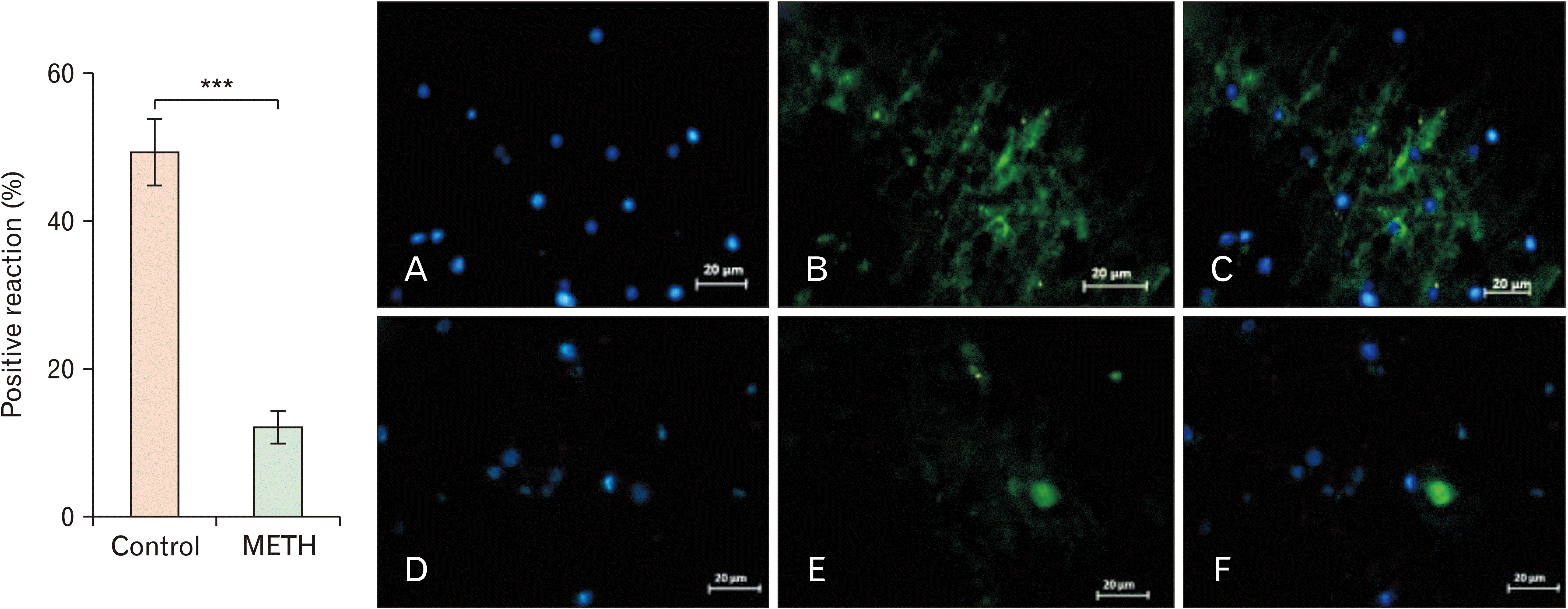 | Fig. 3Expression of BDNF in control and METH groups. This figure presents the expression profiles of BDNF in the control (upper row) and the METH group (lower row). The images encompass the nuclei staining using DAPI (Abcam) (A, D), the BDNF immunostaining (B, E), and the merged images (C, F). The findings decisively reveal the METH-induced reduction in BDNF expression within the METH group when compared to the control group (***P<0.001). BDNF, brain-derived neurotrophic factor; METH, methamphetamine. |
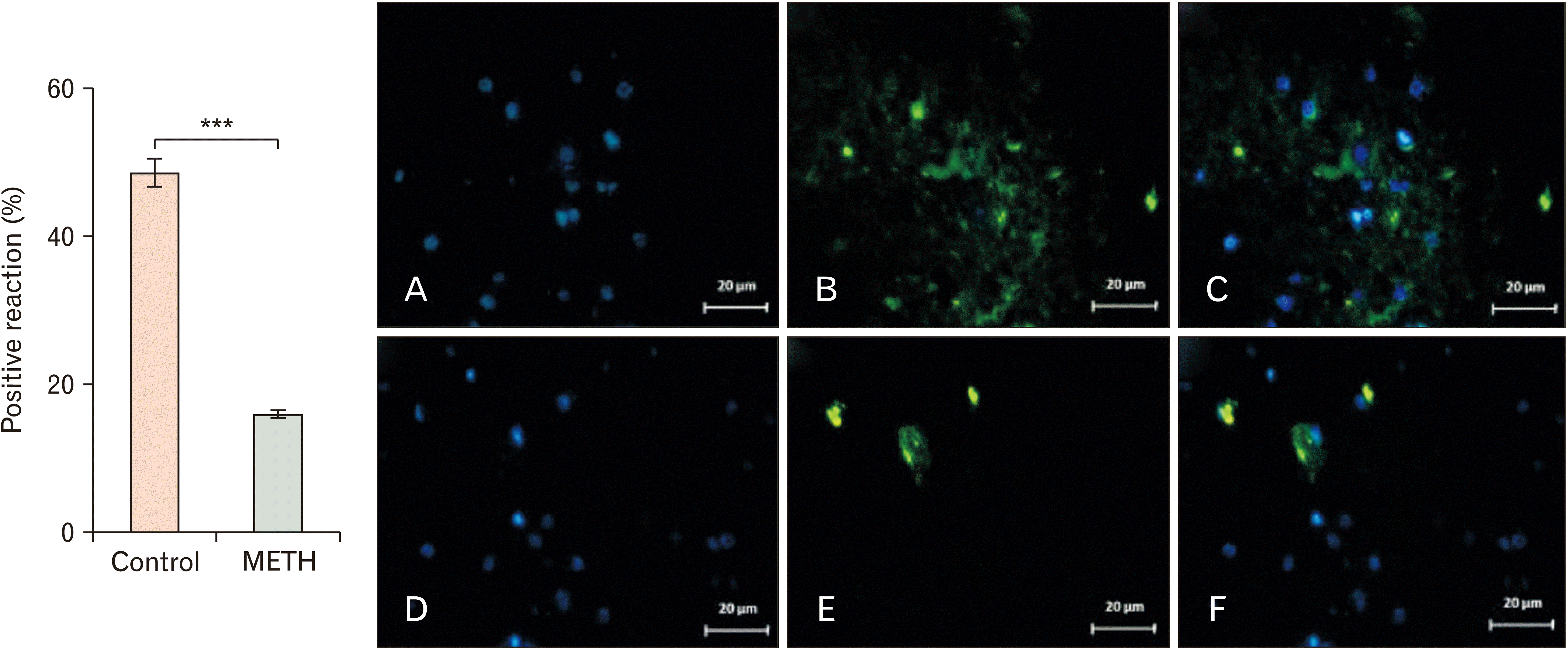 | Fig. 4Akt-1 expression in control and METH groups. This figure assesses the expression of Akt-1 in both the control (upper row) and METH groups (lower row). The panel displays DAPI (Abcam) staining (A, D), Akt-1 immunostaining (B, E), and the merged images (C, F). The findings distinctly reveal that METH administration led to a reduction in Akt-1 expression within the METH group, as compared to the control group, and these alterations held substantial significance (***P<0.001). METH, methamphetamine. |
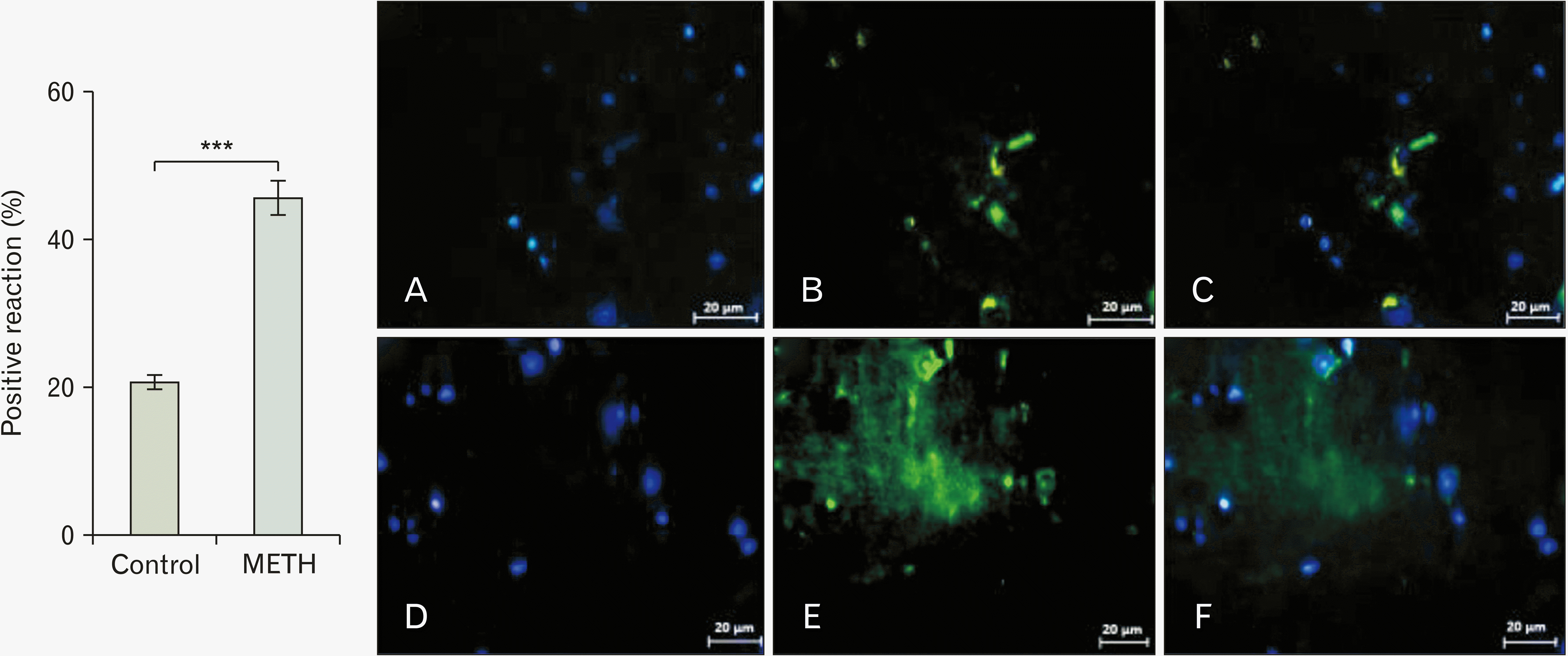 | Fig. 5GSK3 expression in METH and control groups depicted here is the expression status of GSK3 in the control group (upper row) and the METH group (lower row). The images feature DAPI (Abcam) staining (A, D), GSK3 immunostaining (B, E), and the merged images (C, F). The results distinctly indicate that METH exposure prompted an elevation in GSK3 expression within the METH group as opposed to the control group, and these changes carried considerable significance (***P<0.001). METH, methamphetamine. |
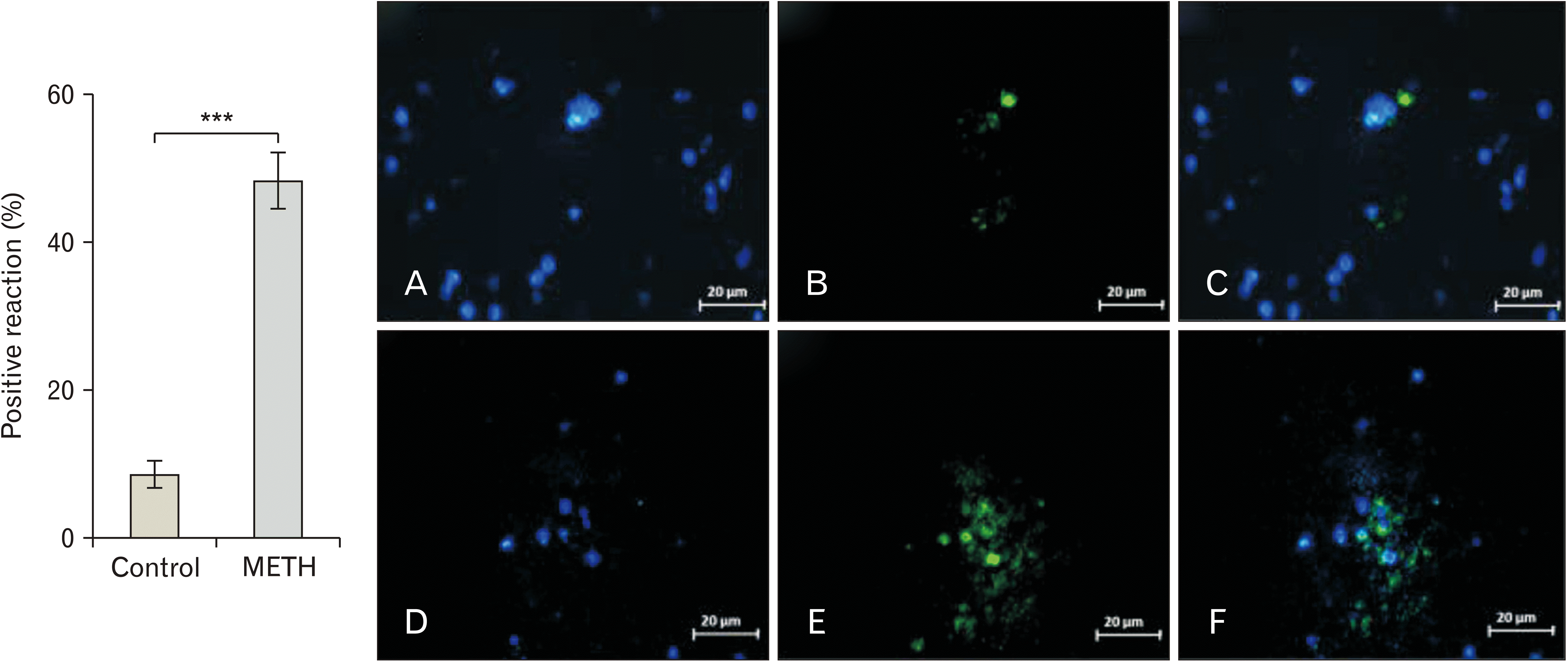 | Fig. 6RIPK3 expression in control and METH groups illustrated are the expression profiles of RIPK3 in the control (upper row) and the METH group (lower row). The images present DAPI (Abcam) staining (A, D), RIPK3 immunostaining (B, E), and the merged images (C, F). The outcomes unequivocally highlight that METH exposure resulted in an increased protein expression of RIPK3 within the METH group compared to the control group, and these changes were highly significant (***P<0.001). METH, methamphetamine. |
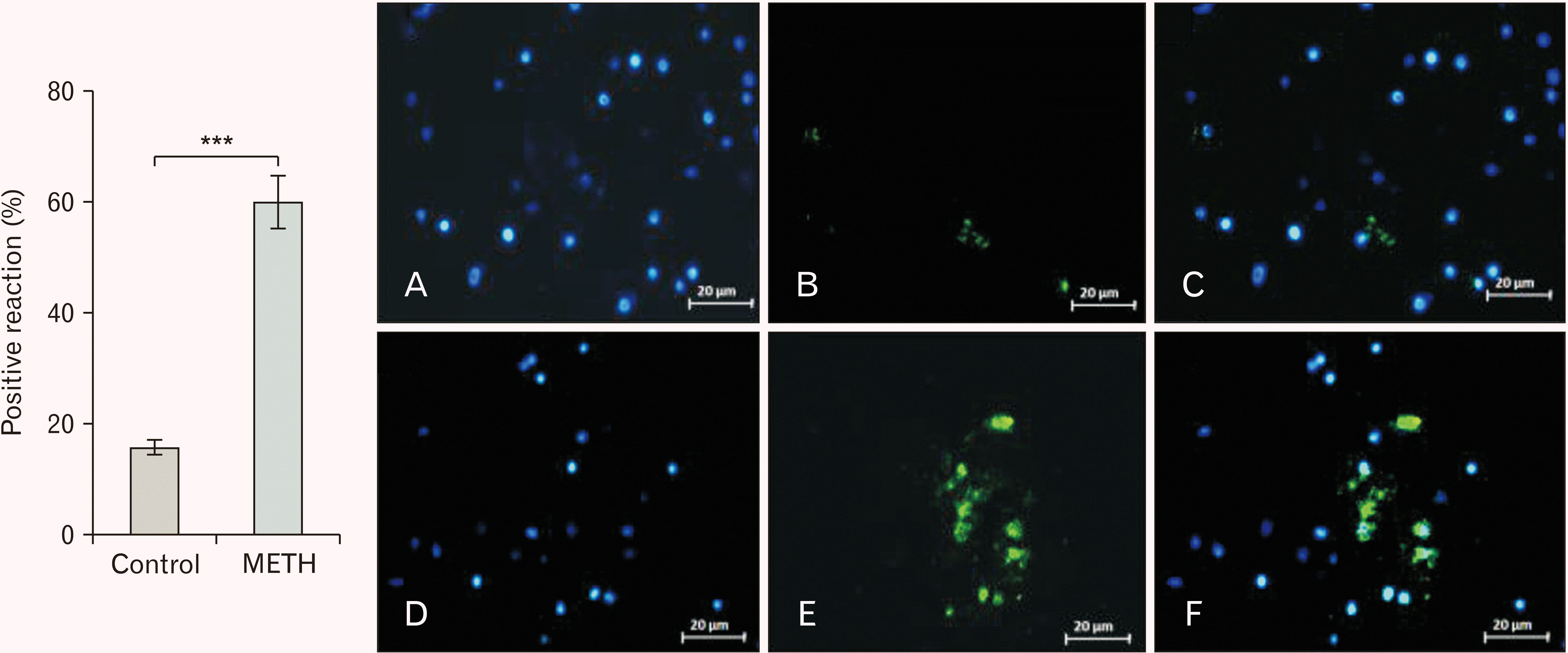 | Fig. 7TNF-α expression in METH and control groups shown in this figure is the TNF-α expression in the control group (upper row) and the METH group (lower row). The images include DAPI (Abcam) staining (A, D), TNF-α Immunostaining (B, E), and the merged images (C, F). The outcomes vividly showcase that METH exposure induced an augmentation in TNF-α expression within the METH group when compared to the control group, and these alterations held remarkable significance (***P<0.001). TNF-α, tumor necrosis factor-α; METH, methamphetamine. |
Tunel assay
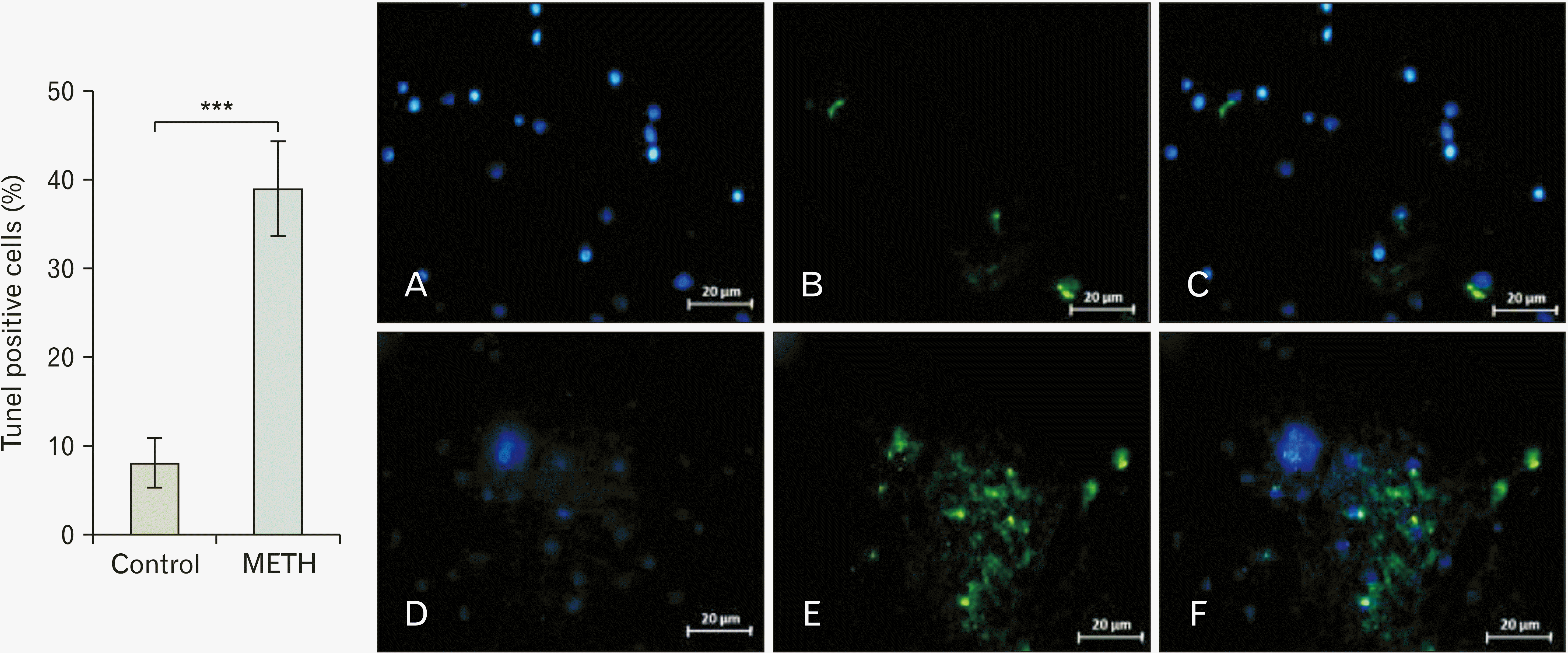 | Fig. 8TUNEL assay results in METH and control groups this figure presents the outcomes of the TUNEL assay within the control group (upper row) and the METH group (lower row). The images encompass DAPI (Abcam) staining (A, D), identification of apoptotic cells (B, E), and the merged images (C, F). The ensuing data substantiates that the presence of apoptotic cells in the METH group demonstrated a substantial increase as contrasted with the control group (***P<0.001). METH, methamphetamine. |
GPX activation, GSSG, ROS
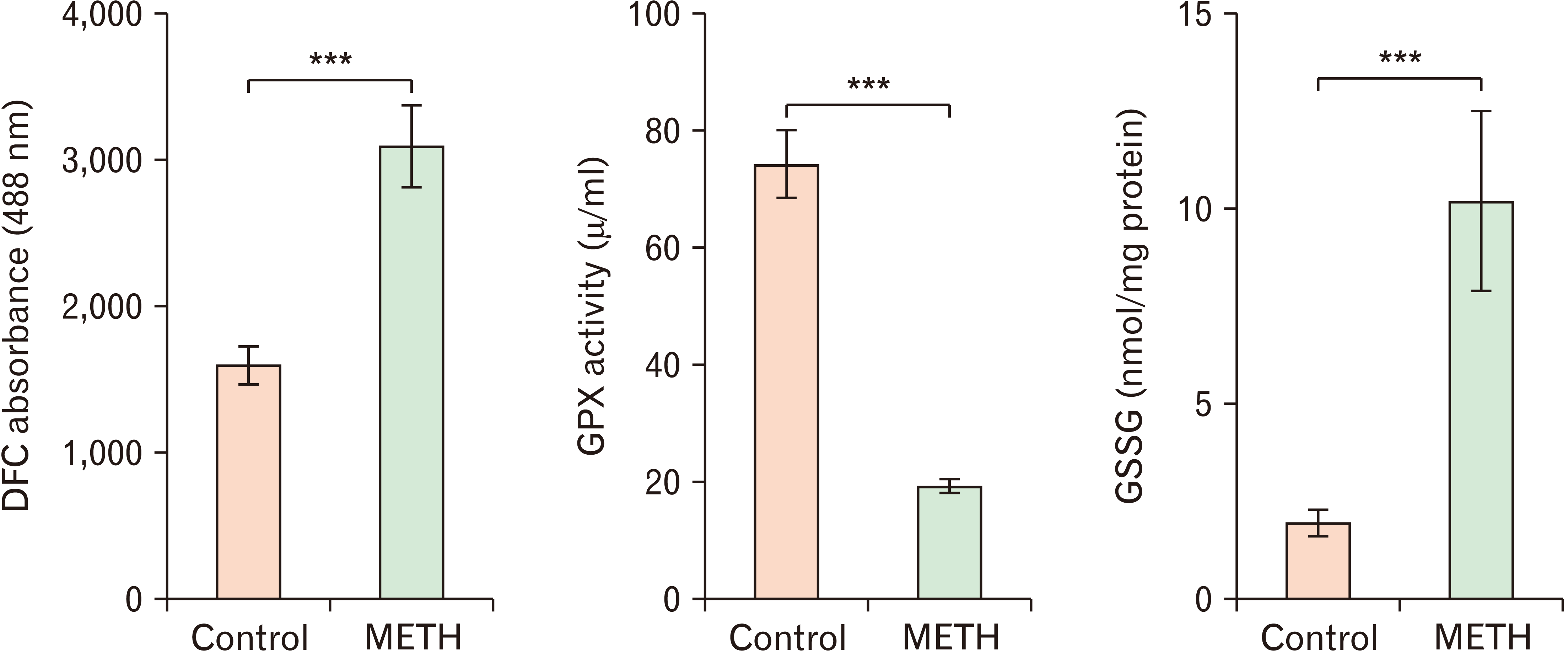 | Fig. 9The figure showcases the results concerning GPX activation, GSSG activity, and ROS levels in both the METH and control groups. It elucidates that METH exposure led to heightened ROS and GSSG activity, while concurrently decreasing GPX activity in comparison with the control group (***P<0.001). DFC, dichlorodihydrofluorescein; GPX, glutathione peroxidase; GSSG, glutathione disulfide; ROS, reactive oxygen species; METH, methamphetamine. |
Stereological analysis of the amygdala
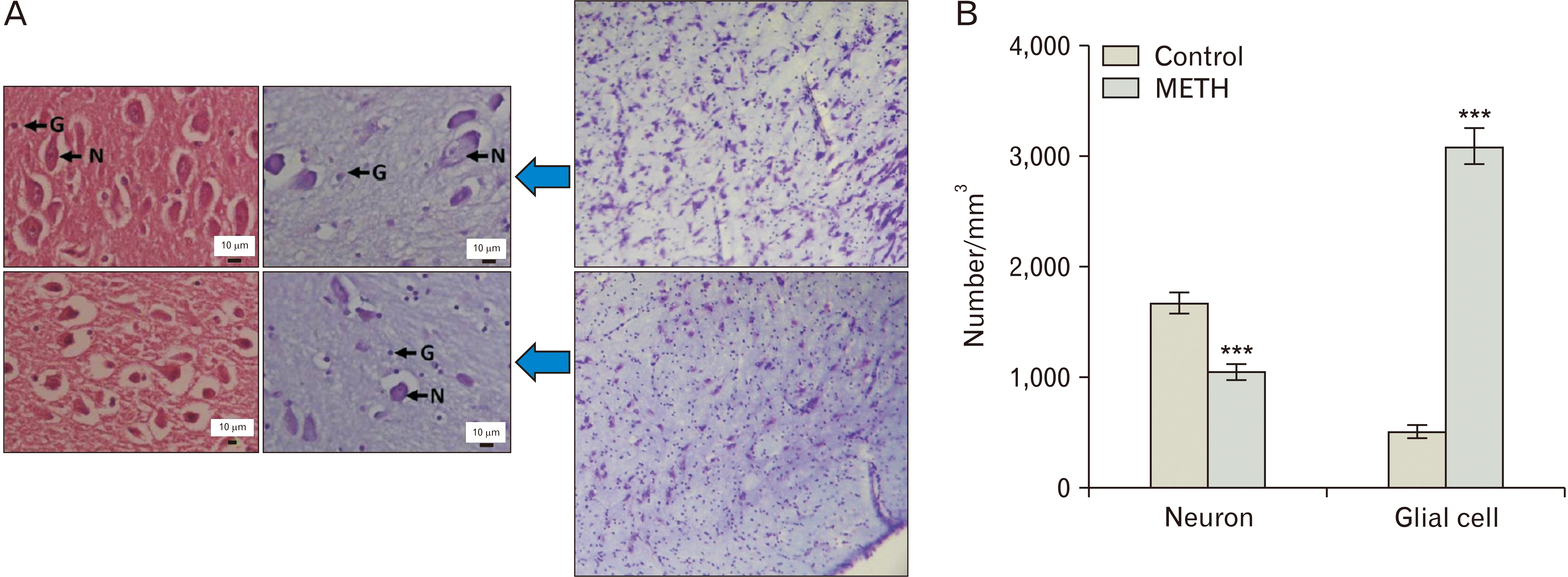 | Fig. 10(A) Photomicrograph and (B) stereological data of neurons and glial cells in control and METH groups. Panel (A) provides a visual representation of the amygdala nuclei stained with H&E and cresyl violet, accentuating the pronounced neuronal vacuolation and gliosis in the control group (upper row) in comparison with METH group (lower row), the panel (B) encompasses stereological data indicating the quantification of neurons and glial cells in both the control and METH groups. Specifically, the number of neurons displayed a reduction in the METH groups when contrasted with the control group, whereas the number of glial cells exhibited an increase (***P<0.001). N, neuron; G, glial cell; METH, methamphetamine. |
Immunoblotting
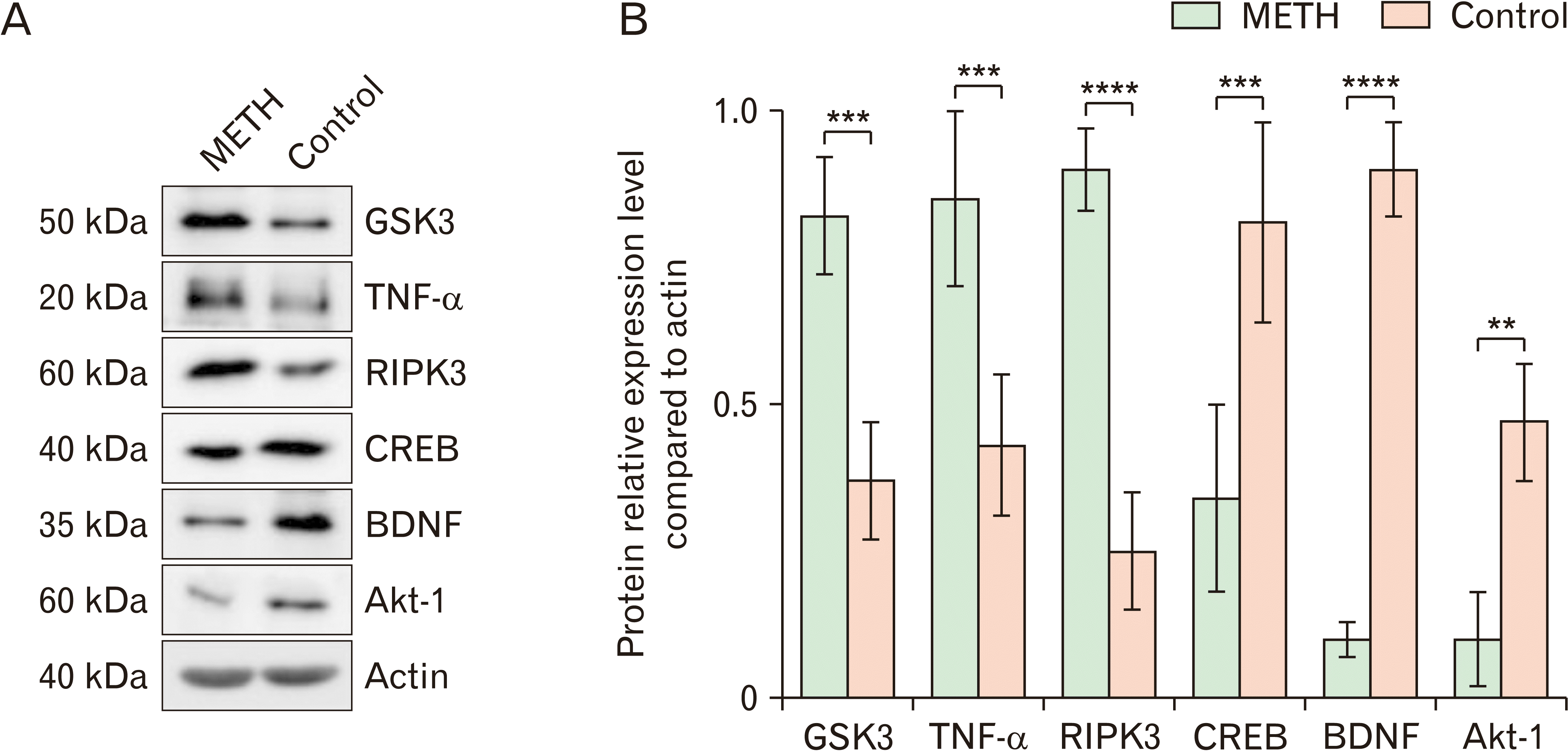 | Fig. 11Immunoblotting analysis of GSK3, TNF-α, RIPK3, CREB, BDNF, and Akt-1 levels in response to METH. This figure demonstrates the outcomes of immunoblotting assessing the levels of GSK3, TNF-α, and RIPK3, along with CREB, BDNF, and Akt-1, in response to METH exposure. ACTIN is effectively used as the loading control in the blots to ensure data accuracy and reliability (**P<0.01, ***P<0.001, ****P<0.0001). TNF-α, tumor necrosis factor-α; CREB, cAMP response element-binding protein; BDNF, brain-derived neurotrophic factor; METH, methamphetamine. |




 PDF
PDF Citation
Citation Print
Print



 XML Download
XML Download